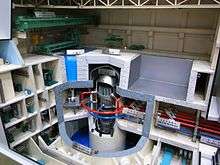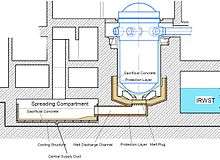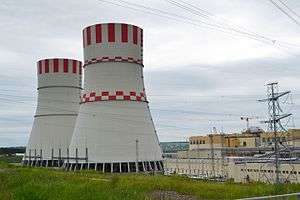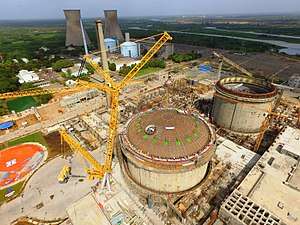Generation III reactor
A Generation III reactor is a development of Generation II nuclear reactor designs incorporating evolutionary improvements in design developed during the lifetime of the Generation II reactor designs. These include improved fuel technology, superior thermal efficiency, significantly enhanced safety systems (including passive nuclear safety), and standardized designs for reduced maintenance and capital costs. The first Generation III reactor to begin operation was Kashiwazaki 6 (an ABWR) in 1996.

Due to the prolonged period of stagnation in the construction of new reactors and the continued (but declining) popularity of Generation II/II+ designs in new construction, relatively few third generation reactors have been built. Generation IV designs are still in development as of 2017, and are not expected to start entering commercial operation until 2020–2030.[1]
Overview
Though the distinction is arbitrary, the improvements in reactor technology in third generation reactors are intended to result in a longer operational life (designed for 60 years of operation, extendable to 100+ years of operation prior to complete overhaul and reactor pressure vessel replacement) compared with currently used Generation II reactors (designed for 40 years of operation, extendable to 60+ years of operation prior to complete overhaul and pressure vessel replacement).[2][3]
The core damage frequencies for these reactors are designed to be lower than for Generation II reactors – 60 core damage events for the EPR and 3 core damage events for the ESBWR[4] per 100 million reactor-years are significantly lower than the 1,000 core damage events per 100 million reactor-years for BWR/4 Generation II reactors.[4]
The third generation EPR reactor was also designed to use uranium more efficiently than older Generation II reactors, using approximately 17% less uranium per unit of electricity generated than these older reactor technologies.[5] An independent analysis conducted by environmental scientist Barry Brook on the greater efficiency and therefore lower material needs of Gen III reactors, corroborates this finding.[6]
Response and criticism

Proponents of nuclear power and some who have historically been critical have acknowledged that third generation reactors as a whole are safer than older reactors.
Edwin Lyman, a senior staff scientist at the Union of Concerned Scientists, has challenged specific cost-saving design choices made for two Generation III reactors, both the AP1000 and ESBWR. Lyman, John Ma (a senior structural engineer at the NRC), and Arnold Gundersen (an anti-nuclear consultant) are concerned about what they perceive as weaknesses in the steel containment vessel and the concrete shield building around the AP1000 in that its containment vessel does not have sufficient safety margins in the event of a direct airplane strike.[7][8] Other engineers do not agree with these concerns, and claim the containment building is more than sufficient in safety margins and factors of safety.[8][9]
The Union of Concerned Scientists in 2008 referred to the EPR as the only new reactor design under consideration in the United States that "...appears to have the potential to be significantly safer and more secure against attack than today's reactors."[10]:7
There have also been issues in fabricating the precision parts necessary to maintain safe operation of these reactors, with cost overruns, broken parts, and extremely fine steel tolerances causing issues with new reactors under construction in France at the Flamanville Nuclear Power Plant.[11]
Existing and future reactors
The first Generation III reactors were built in Japan, in the form of Advanced Boiling Water Reactors. In 2016 a Generation III+ VVER-1200/392M reactor became operational at Novovoronezh Nuclear Power Plant II in Russia, which was the first operational Generation III+ reactor.[12] Several other Generation III+ reactors are under late-stage construction in Europe, China, India, and the United States. The next Generation III+ reactor to come online is a Westinghouse AP1000 reactor, the Sanmen Nuclear Power Station in China, which was scheduled to become operational in 2015.[13] It has been completed and achieved criticality on June 21, 2018, and entered into commercial operation on September 21, 2018.
In the United States, reactor designs are certified by the Nuclear Regulatory Commission (NRC). As of October 2014 the commission has approved five designs, and is considering another five designs as well.[14]
Generation III reactors
Generation III reactors currently operational or under construction
| Developer(s) | Reactor name(s) | Type | MWe (net) | MWe (gross) | MWth | Notes |
|---|---|---|---|---|---|---|
| General Electric, Toshiba, Hitachi | ABWR; US-ABWR |
BWR | 1350 | 1420 | 3926 | In operation at Kashiwazaki since 1996. NRC certified in 1997.[10] |
| KEPCO | APR-1400 | PWR | 1383 | 1455 | 3983 | In operation at Kori since Jan 2016. |
| CGNPG | ACPR-1000 | 1061 | 1119 | 2905 | Improved version of the CPR-1000. First reactor is due to come online in 2018 at Yangjiang-5. | |
| CGNPG, CNNC | Hualong One; HPR-1000 |
1090 | 1170 | 3050 | In part a merger of the Chinese ACPR-1000 and ACP-1000 designs, but ultimately an incrementally developed improvement on the prior CNP-1000 and CP-1000 designs.[15] It was initially intended to be named the "ACC-1000", but was ultimately named as the "Hualong One" or "HPR-1000". Fangchenggang Units 3–6 will be the first to utilize the HPR-1000 design, with Units 3 & 4 currently under construction as of 2017.[16] | |
| OKBM Afrikantov | VVER-1000/428 | 990 | 1060 | 3000 | First version of the AES-91 design, designed and used for Tianwan Units 1 & 2, which came online in 2007. | |
| VVER-1000/428M | 1050 | 1126 | 3000 | Another version of the AES-91 design, also designed and used for Tianwan (this time for Units 3 & 4, which came online in 2017 and 2018, respectively). | ||
| VVER-1000/412 | 917 | 1000 | 3000 | First constructed AES-92 design, used for the Kudankulam. | ||
| BN-800 | FBR | 789 | 885 | 2100 | Demonstration sodium-cooled fast breeder reactor in full (100% power) commercial operation since 2016 at Beloyarsk-4. | |
Generation III designs not adopted or built yet
| Developer(s) | Reactor name(s) | Type | MWe (net) | MWe (gross) | MWth | Notes |
|---|---|---|---|---|---|---|
| General Electric, Hitachi | ABWR-II | BWR | 1638 | 1717 | 4960 | Improved version of the ABWR. Uncertain development status. |
| Mitsubishi | APWR; US-APWR; EU-APWR; APWR+ |
PWR | 1600 | 1700 | 4451 | Two units planned at Tsuruga cancelled in 2011. US NRC licensing for two units planned at Comanche Peak was suspended in 2013. The original APWR and the updated US-APWR/EU-APWR (also known as the APWR+) differ significantly in their design characteristics, with the APWR+ having higher efficiency and electrical output. |
| Westinghouse | AP600 | 600 | 619 | ? | NRC certified in 1999.[10] Evolved into the larger AP1000 design.[17] | |
| Combustion Engineering | System 80+ | 1350 | 1400 | ? | NRC certified in 1997.[10] Provided a basis for the Korean APR-1400.[18] | |
| OKBM Afrikantov | VVER-1000/466(B) | 1011 | 1060 | 3000 | This was the first AES-92 design to be developed, originally intended to be built at the proposed Belene Nuclear Power Plant, but construction was later halted. | |
| Candu Energy Inc. | EC6 | PHWR | ? | 750 | 2084 | The EC6 (Enhanced CANDU 6) is an evolutionary upgrade of previous CANDU designs. Like other CANDU designs, it is capable of using unenriched natural uranium as fuel. |
| AFCR | ? | 740 | 2084 | The Advanced Fuel CANDU Reactor is a modified EC6 design that has been optimized for extreme fuel flexibility with the ability to handle numerous potential reprocessed fuel blends and even thorium. It is currently undergoing late-stage development as part of a joint venture between SNC-Lavalin, CNNC, and Shanghai Electric. | ||
| Various (see MKER Article.) | MKER | BWR | 1000 | ? | 2085 | A Development of the RBMK nuclear power reactor. Fixes all of the RBMK reactor's design errors and flaws and adds a full containment building and Passive nuclear safety features such as a passive core cooling system. The physical prototype of the MKER-1000 is the 5th unit of the Kursk Nuclear Power Plant. The construction of Kursk 5 was cancelled in 2012 and a VVER-TOI whose construction is ongoing since 2018 is being built instead as of 2018.[19][20][21](see RBMK article) |
Generation III+ reactors

Generation III+ designs offer significant improvements in safety and economics over Generation III advanced reactor designs.[22]

Generation III+ reactors currently operational or under construction
| Developer(s) | Reactor name(s) | Type | MWe (net) | MWe (gross) | MWth | 1st grid connection | Notes |
|---|---|---|---|---|---|---|---|
| Westinghouse, Toshiba | AP1000 | PWR | 1117 | 1250 | 3400 | 2018-06-30 Sanmen[23] | NRC certified Dec 2005.[10] |
| SNPTC, Westinghouse | CAP1400 | 1400 | 1500 | 4058 | The first Chinese co-developed and upsized "native" version/derivative of the AP1000. Westinghouse's co-development agreement gives China the IP rights for all co-developed plants >1350 MWe. First two units currently under construction at Shidao Bay. The CAP1400 is planned to be followed by a CAP1700 and/or a CAP2100 design if the cooling systems can be scaled up by far enough. | ||
| Areva | EPR | 1660 | 1750 | 4590 | 2018-06-29 Taishan[24] | ||
| Areva, Mitsubishi | ATMEA1 | 1150 | ? | 3150 | First unit expected to be completed by 2023 at Sinop. | ||
| OKB Gidropress | VVER-1200/392M | 1114 | 1180 | 3200 | 2016-08-05 Novovoronezh II[25][26] | The VVER-1200 series is also known as the AES-2006/MIR-1200 design. This particular model was the original reference model used for the VVER-TOI project. | |
| VVER-1200/491 | 1085 | 1199 | 3200 | 2018-03-09 Leningrad II[27] | |||
| VVER-1200/509 | 1114 | 1200 | 3200 | Under construction in Akkuyu 1. | |||
| VVER-1200/523 | 1080 | 1200 | 3200 | Under construction in Ruppur 1-2. | |||
| VVER-1200/513 | ? | 1200 | 3200 | Standardized version of the VVER-1200 based in part on the VVER-1300/510 design (which is the current reference design for the VVER-TOI project). First unit expected to be completed by 2022 at Akkuyu. | |||
| BARC | IPHWR-700 | PHWR | 630 | 700 | 2166 | 2020 | Successor of indigenous 540MWe PHWR with increased output and additional safety features. Under construction and due to come online in 2020. Unit 3 at Kakrapar Atomic Power Station achieved first criticality on 22nd July 2020. |
Generation III+ designs not adopted or built yet
| Developer(s) | Reactor name(s) | Type | MWe (net) | MWe (gross) | MWth | Notes |
|---|---|---|---|---|---|---|
| Toshiba | EU-ABWR | BWR | ? | 1600 | 4300 | Updated version of the ABWR designed to meet EU guidelines, increase reactor output, and improve design generation to III+. |
| Areva | Kerena | 1250 | 1290 | 3370 | Previously known as the SWR-1000. Based on German BWR designs, mainly that of Gundremmingen units B/C. Co-developed by Areva and E.ON. | |
| General Electric, Hitachi | ESBWR | 1520 | 1600 | 4500 | Based on the ABWR. Being considered for North Anna-3. Eschews the use of recirculation pumps entirely in favor of a design completely reliant on natural circulation (which is very unusual for a boiling water reactor design). | |
| KEPCO | APR+ | PWR | 1505 | 1560 | 4290 | APR-1400 successor with increased output and additional safety features. |
| OKB Gidropress | VVER-1300/510 | 1115 | 1255 | 3300 | The VVER-1300 design is also known as the AES-2010 design, and is sometimes mistakenly designated as the VVER-TOI design. The VVER-1300/510 is based on the VVER-1200/392M that was originally used as the reference design for the VVER-TOI project, although the VVER-1300/510 now serves that role (which has led to confusion between the VVER-TOI plant design and the VVER-1300/510 reactor design). Multiple units are currently planned for construction at several Russian nuclear plants. | |
| VVER-600/498 | ? | 600 | 1600 | Essentially a scaled-down VVER-1200. Commercial deployment planned by 2030 at Kola. | ||
| Candu Energy Inc. | ACR-1000 | PHWR | 1085 | 1165 | 3200 | The Advanced CANDU Reactor is a hybrid CANDU design that retains the heavy water moderator but replaces the heavy water coolant with conventional light water coolant, significantly reducing costs compared to traditional CANDU designs but losing the characteristic CANDU capability of using unenriched natural uranium as fuel. |
See also
- Generation II reactor
- Generation IV reactor
- List of reactor types
References
- "Generation IV Nuclear Reactors". World Nuclear Association.
- "New material promises 120-year reactor lives". www.world-nuclear-news.org. Retrieved 8 June 2017.
- "Advanced Nuclear Power Reactors | Generation III+ Nuclear Reactors - World Nuclear Association". www.world-nuclear.org. Retrieved 8 June 2017.
- Next-generation nuclear energy: The ESBWR
- page 126. 3 Rs of Nuclear Power: Reading, Recycling, and Reprocessing Making a Better ... By Jan Forsythe
- Fuel use of gen 3 nuclear
- Adam Piore (June 2011). "Nuclear energy: Planning for the Black Swan". Scientific American. Missing or empty
|url=(help) - Matthew L. Wald. Critics Challenge Safety of New Reactor Design New York Times, April 22, 2010.
- "Sunday Dialogue: Nuclear Energy, Pro and Con". New York Times. February 25, 2012.
- "Nuclear Power in a warming world" (PDF). Union of Concerned Scientists. Dec 2007. Retrieved 1 October 2008.
- "Flaw found in French nuclear reactor - BBC News". BBC News. Retrieved 2015-10-29.
- "В России запустили не имеющий аналогов в мире атомный энергоблок".
- "China Nuclear Power". World Nuclear Association. Retrieved 2014-07-14.
- "Design Certification Applications for New Reactors". U.S. Nuclear Regulatory Commission.
- Xing, Ji; Song, Daiyong; Wu, Yuxiang (1 March 2016). "HPR1000: Advanced Pressurized Water Reactor with Active and Passive Safety". Engineering. 2 (1): 79–87. doi:10.1016/J.ENG.2016.01.017.
- "China's progress continues". Nuclear Engineering International. 11 August 2015. Retrieved 30 October 2015.
- "New Commercial Reactor Designs". Archived from the original on 2009-01-02.
- "Archived copy". Archived from the original on 2012-12-11. Retrieved 2009-01-09.CS1 maint: archived copy as title (link)
- http://world-nuclear.org/information-library/country-profiles/countries-o-s/russia-nuclear-fuel-cycle.aspx
- http://sovietologist.blogspot.com/2008/04/future-of-water-cooled-graphite.html?m=1
- http://reactors.narod.ru/mker/mker.html
- http://www.gnep.energy.gov/pdfs/FS_GenIV.pdf%5B%5D DEAD URL - Try http://nuclear.energy.gov/pdfFiles/factSheets/NGNP-GENIV-Final-Jan31-07.pdf%5B%5D
- "First Westinghouse AP1000 Plant Sanmen 1 Begins Synchronization to Electrical Grid". Retrieved 2018-07-02.
- http://www.world-nuclear-news.org/NN-Chinas-Taishan-1-reactor-connected-to-grid-29061801.html
- "В России запустили не имеющий аналогов в мире атомный энергоблок".
- "First VVER-1200 reactor enters commercial operation - World Nuclear News". www.world-nuclear-news.org. Retrieved 2019-07-10.
- "Leningrad II-1 starts pilot operation". World Nuclear News. 9 March 2018. Retrieved 10 March 2018.